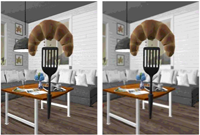
Adjusting Stereoscopic Parameters by Evaluating the Point of Regard in a Virtual Environment
Jessica Conti, Benoît Ozell, Eric Paquette, Patrice Renaud,
Computers & Graphics, Volume 69, pp 24–35, 2017.
Presented at the CHCCS Graphics Interface 2018 Conference, Toronto, ON, Canada, May 8-11, 2018
